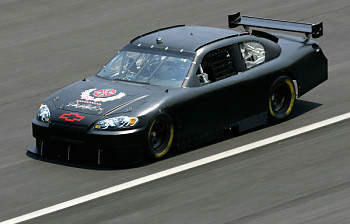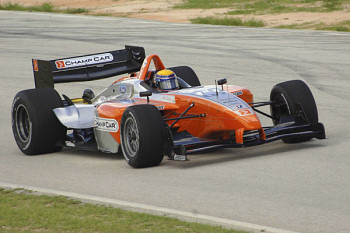The Way It Is/ The Spec Car Age is here to stay. Who will get it right?
by Gordon Kirby I've written a number of times this year about the Great Spec Car Invasion. I've also written in detail about Champ Car's new Panoz spec car, NASCAR's Car of Tomorrow spec car, and Formula One's engine freeze, and this trio of congruent historical occurences should make it abundantly clear that just six years into the 21st Century the spec car age has well and truly arrived across the entire spectrum of automobile racing.
I've written a number of times this year about the Great Spec Car Invasion. I've also written in detail about Champ Car's new Panoz spec car, NASCAR's Car of Tomorrow spec car, and Formula One's engine freeze, and this trio of congruent historical occurences should make it abundantly clear that just six years into the 21st Century the spec car age has well and truly arrived across the entire spectrum of automobile racing.
For years, many of the sport's old-timers have bemoaned the coming of this new age. We feel it's tearing the innovative soul--the thing many of us believe is the sport's primary motivating factor--out of modern motor racing. I've expounded about this occurence at some length in previous columns this year and will simply add that, again like many others, I feel a great sadness about the passing of the age of innovation in racing. Never again will we see the likes of a Chaparral or Porsche 917/30 CanAm car, or Lotus 25 or 79 Formula One car, or ‘72 Eagle Indy car, or great battles between car builders like we once saw between March versus Lola vs Penske vs Reynard.
Even Formula One seems to be teetering towards what will essentially be a spec car future. F1's engine freeze is the harbinger of more and more restrictions on technology by the FIA. A common ECU is inevitable in F1 and of course, although some people don't like to acknowledge it, most of today's cars--overall aero configuration, chassis shape and design, fuel tank placement, etc--are strictly defined by the FIA. There's no room in the rulebook to produce a Lotus 25, or Lotus 79, or Brabham fan car. "Have they been reading our rulebook?" remarked NASCAR's technical director Robin Pemberton after he read last month's column about this year's F1 engine development and next year's freeze.
Sometimes I wonder if the rest of racing will follow NASCAR to the bitter end and ban computers and data systems during race weekends. That would be fine with many engineers who won't have to go to the races! They would only have to go to test sessions and primarily do simulations back at the shop. Indeed, it may be that the sport would be better off if the engineers spent more time at home than at the racetrack....

© Streeter Lecka/Getty Images for NASCAR
For NASCAR, the technical part was easy compared to what the rulesmakers had to deal with in F1, CanAm, CART and GTP-type sports car racing. Stock car racing never was about technology. NASCAR cars were always strictly defined and limited. Fuel injection for example, was always verboten in NASCAR and there was zero room for the development of things like rear-engine cars, turbocharging, composite chassis and ground effects. As we all know, the basic stock car package--chassis, suspension, engine and drivetrain--is based entirely on 1950s technology.
But as documented recently in this column, NASCAR begins the greatest technical change in its history next year with the introduction of the Car of Tomorrow. NASCAR has been going down the spec car route for a long time and its CoT completes the process with everyone compelled to run exactly the same chassis and bodywork. NASCAR says it's making the move to improve safety and attempt to reduce costs for the smaller teams at least, but at this point many people question whether those goals will be achieved.
Recently, I had an interesting conversation with Rick Mears. We got to talking about NASCAR and the Car of Tomorrow and Mears chuckled. "I hear those guys complaining all the time about aero push and how they can't pass, and how they want more banking and more banking," Mears remarked. "Well, the thing is, it's all about the aero. They need to change the aero part of it."
Mears believes NASCAR should have bit the bullet on downforce and made a big cut, but the CoT appears to take a different tack on this issue. "Instead of going to a splitter like they have with this new car," Rick remarked, "they should have taken the old nose and cut off the bottom of the air dam--make some room between the bottom of the dam and the road. That would have made it more like it used to be, more reliant on the mechanical side than the aero. With that splitter on the front and a wing on the back, they're just making it more about aero. I'm not sure it's going to fix their problems."
These are interesting observations from one of racing's most accomplished drivers, particularly on ovals. Of course, drivers, least of all former drivers, are rarely listened to by the rulesmakers....
Meanwhile, Champ Car's reasons for going to a spec car are economic--to try to reduce the cost of entry--and also to attempt to make for closer racing. The time has come to replace the excellent but aging Lola B2/00 which had become the series de facto spec car and is now seven years old and running out of parts. The cost of most major components of the new Panoz are close to half the cost of similar parts of the recent Lola chassis and that should make it possible for more teams to enter the series. Panoz chief designer Simon Marshall admits that meeting Champ Car's cost control requirements has been a serious challenge.
"To design a car at the level of a Champ car and also keep it economical is very difficult," Marshall remarked. "If you look at the car, there are no cheap parts. It all comes down to the amount of time we spend designing this car. Hopefully, we've done it right and the investment upfront in the safety and performance of the car will continue for three or maybe four years, and we can spread that investment over a high volume of parts and cars.

© LAT/USA
There's been lots of debate about what technical items should or shouldn't be opened-up for development by the teams in 2008 and beyond. "For 2007, there's no question we're locking everything down," emphasized Champ Car's technology director Scot Elkins. "The key component to 2007 is to make the car race well so that we put on a good show at the venues we go to. There's no question that racing is entertainmnet and we have to do that part first.
"After 2007, the philosophy seems to stem from the fact that the majority of the engineering staff that are involved in motor sports and Champ Car right now are mechanical engineers. So I think a lot of the mechanical aspects of the car--different rocker positions, going testing on four and seven-post rigs--I think those are the things we want to open up. They are very effective mechanical engineering methods to make the car go faster, but they don't cost like a wind tunnel program does. So I think those are the areas we want to allow.
"I'm a bit hesitant to open up the aerodynamics," Elkins added. "We've tried to do something really big with that and I'm afraid we're going to lose our control over the raceability of the car if we open it up to the teams. I think the mechanical aspects are the best ways for us to open up development in 2008."
The other primary goal with the DP01 was to try to produce a car that could race in closer quarters and pass more easily. The concept was to produce less of the overall downforce from the front and rear wings and proportionally more from the underwing. The new Panoz makes around 5,500 pounds of downforce at 200 mph with the underwing accounting for nearly fifty percent of the total downforce.
"What we tried to do was keep the total downforce the same as the current cars but make the cars race better," said Champ Car's Elkins. "We did that by increasing the lift over drag, making the car less susceptible to turbulence from another race car. To do that, we simply redistributed the aerodynamics from the wing into the underbody.
"It's not a theory," he added. "It's an actual fact. We're making downforce more effectively so we're having less downforce from the wings which in theory will make it a little bit easier for the cars to run close and be able to pass, making better racing and making our fans happier."
Added Panoz chief designer Marshall. "It's given us a good chance to wipe the slate clean, break away from certain regulations which don't make sense today, and rewrite the Champ Car rulebook," Marshall commented.
Carl Haas is one team owner who has considerable reservations about the spec car phenomenom. "I wish they wouldn't call it a spec car," Haas says. "I don't like the idea of a spec car and I don't think the fans do either. I can tell you it's not something that I think is attractive to sponsors either, and sponsors are very hard to find today. The other thing is you build a race team to improve and develop your cars. That's what it's all about. Those are the kinds of things we've invested in in this team."
In contrast to NASCAR's CoT, the new Champ car is at least aesthetically pleasing. Everyone seems to like the look of the DP01. In fact, an important part of the design criteria for the DP01 was that it should retain the overall look of recent Champ cars and be pleasing to the eye. In that way, Champ Car and Panoz have done a much better job than NASCAR.
Of course, it won't be long before we find out who's done the best job of achieving their goals as the world's first two major league spec cars take to the track next season. As always, the proof will be in the pudding when Champ Car's new Panoz and NASCAR's Car of Tomorrow start racing and running together in close quarters, each in their own very different environments.
Either way, the arrival of these spec cars will have revolutionary effects on their respective forms of racing. Five years from now, it will be interesting to gauge the results.
Auto Racing ~ Gordon Kirby
Copyright 2006 ~ All Rights Reserved
Copyright 2006 ~ All Rights Reserved
Top of Page